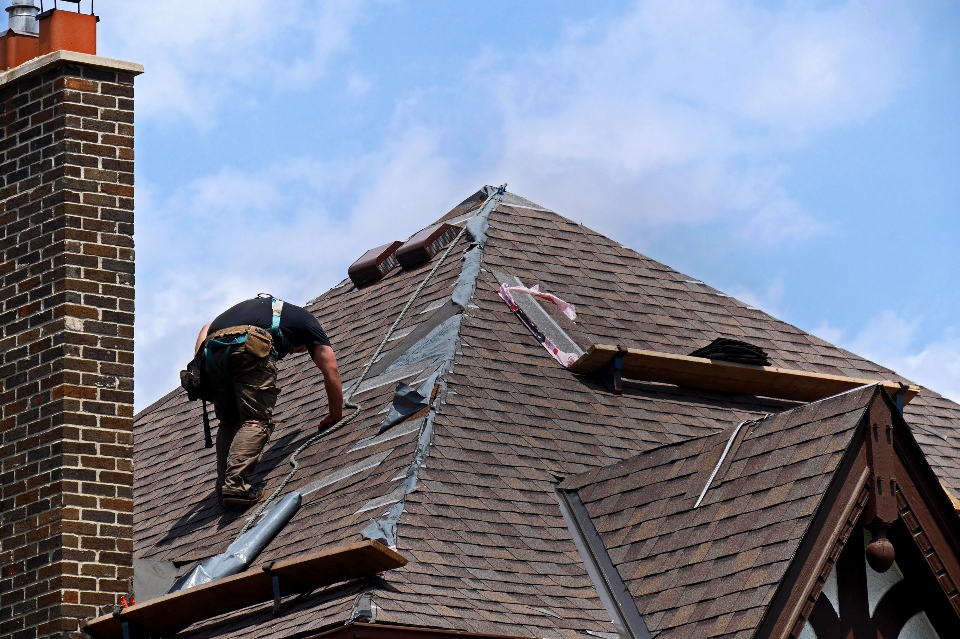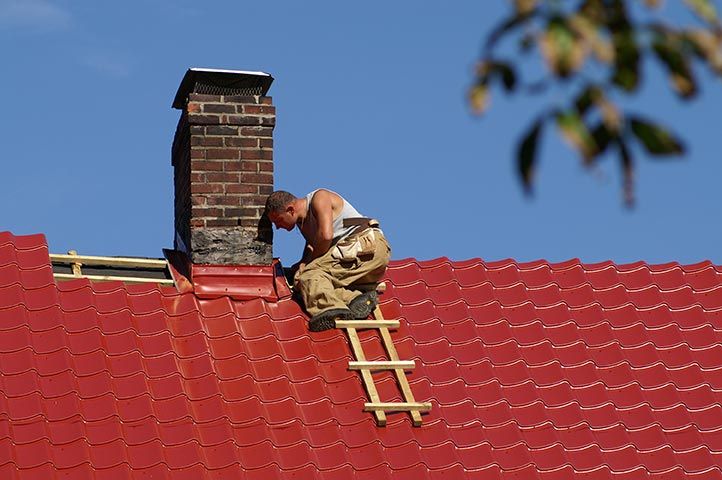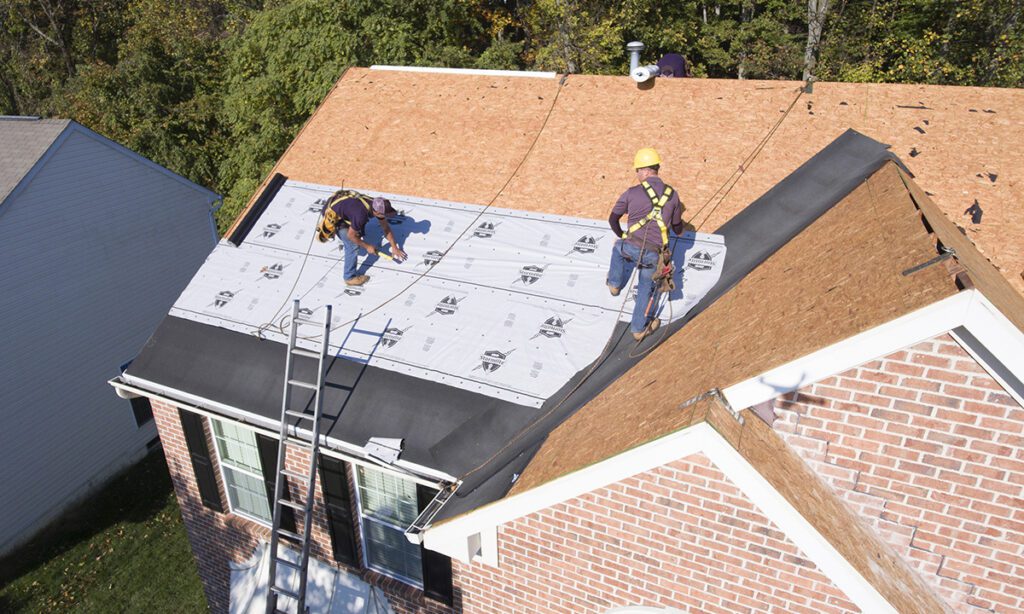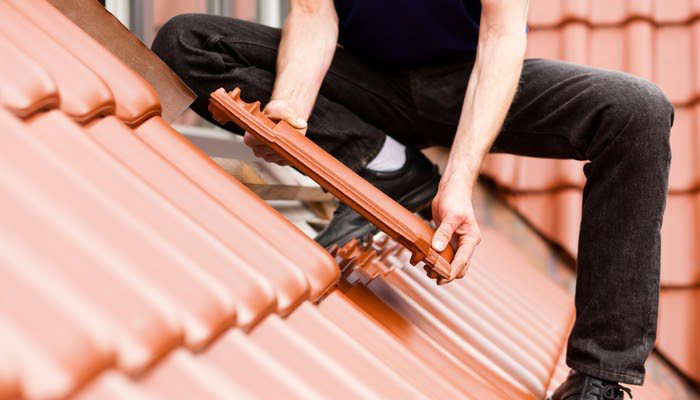Have you ever wondered if repairing your own roof is a challenging task? Many homeowners find themselves facing this question at some point, unsure of whether they should tackle the repairs themselves or hire a professional. In this article, we will explore the pros and cons of DIY roof repair, providing you with valuable insights to help you make an informed decision. So, put on your thinking cap and let’s get started!

Roof Repair Basics
Assessing the Damage
When it comes to repairing your roof, the first step is to assess the extent of the damage. Take the time to carefully inspect your roof, looking for signs of leaks, missing or damaged shingles, and any other issues that may be compromising its integrity. This will help you determine the scope of the repairs needed and what materials and tools you will require.
Gathering the Necessary Tools and Materials
Before you begin the repair process, it’s essential to gather all the necessary tools and materials. Basic tools such as a hammer, tape measure, utility knife, and ladder will be needed, as well as specific roofing tools like a roofing nailer and pry bar. Additionally, you will need safety gear such as goggles, gloves, and a harness, along with the materials needed for the repair, such as shingles, flashing, and roof cement.
Ensuring Safety Precautions
Safety should always be your top priority when undertaking any DIY project, and roof repair is no exception. Ensure you are familiar with the necessary safety precautions, including wearing proper safety gear, using fall protection equipment, and working on dry and stable surfaces. It’s also crucial to avoid hazardous weather conditions and to have a buddy system in place when working on your roof.
Removing Damaged Shingles
In many cases, damaged shingles will need to be removed and replaced during a roof repair. This involves carefully lifting the surrounding shingles and using a pry bar to remove the damaged one. Take care not to cause any further damage to the surrounding shingles or roof structure during this process. Once the damaged shingle is removed, you can proceed with installing a new one in its place.
Replacing/Repairing Flashings
Flashings are the material used to provide a watertight seal around roof penetrations and transitions. Over time, flashings can become damaged or deteriorate, leading to potential leaks. Repairing or replacing flashings is an essential step in roof repair. This may involve removing old flashing, cleaning the area, and installing new flashings using appropriate techniques and materials.
Fixing Leaks
One of the most common roof problems is leaks, and addressing them promptly is crucial to prevent further damage to your home. Identify the source of the leak and take steps to repair it, such as sealing the area with roof cement or applying a patch. Keep in mind that leaks can sometimes be tricky to locate, so patience and thoroughness are key when fixing them.
Addressing Structural Issues
In addition to addressing specific damage, it’s important to address any underlying structural issues during roof repair. This may involve reinforcing or replacing damaged roof decking, correcting sagging or uneven sections, or addressing inadequate support. It’s essential to ensure the structural integrity of your roof to prevent further problems down the line.
Working with Different Roofing Materials
Different roofing materials require different repair techniques and considerations. Whether you have a shingle, metal, tile, or flat roof, it’s important to understand the specific characteristics and maintenance requirements of your roofing material. Familiarize yourself with the proper techniques for working with your chosen material to ensure effective and long-lasting repairs.
Navigating Sloped vs. Flat Roofs
One important factor to consider when repairing your roof is whether it is sloped or flat. The slope of your roof can impact the difficulty and safety of the repair process. Working on a sloped roof requires extra caution and may require additional safety measures, such as the use of harnesses or scaffolding. Flat roofs, on the other hand, may require different repair techniques due to their unique design and drainage considerations.
Understanding Code Compliance
When repairing your roof, it’s vital to ensure that your work complies with local building codes and regulations. Building codes exist to ensure the safety and integrity of structures, and adhering to them is essential. Familiarize yourself with the specific codes and permits required for roof repairs in your area to ensure that your repairs meet the necessary standards.
When to DIY and When to Hire a Professional
Factors to Consider
Deciding whether to tackle a roof repair project yourself or hire a professional can be a challenging decision. Several factors should be considered before making a choice. These factors include the extent of the damage, your skills and experience, the time and effort required, and your budget for the project.
Pros and Cons of DIY Roof Repair
DIY roof repair has both advantages and disadvantages to consider. The main benefits of DIY repairs include potential cost savings, the ability to work at your own pace, and the satisfaction of completing a project on your own. However, there are also downsides to consider, such as the physical demands and safety risks involved, the lack of expertise and knowledge in handling complex issues, and the potential for mistakes that could lead to further damage or the need for professional intervention.
Benefits of Hiring a Professional
While DIY repairs can be tempting, there are several benefits to hiring a professional roofer for your repair needs. Professional roofers have the necessary skills, knowledge, and experience to handle a wide range of roof repair tasks efficiently and effectively. They can quickly assess the extent of the damage, recommend the best course of action, and ensure that the repairs are completed to the highest standards. Hiring a professional also provides you with a degree of peace of mind, knowing that the job is in capable hands.
Choosing the Right Contractor
If you decide to hire a professional roofer, it’s essential to choose the right contractor for the job. Take the time to research and vet potential contractors, checking their credentials, experience, and customer reviews. Request multiple quotes and compare them to ensure you are getting a fair price for the work. It’s also important to verify that the contractor is licensed, insured, and offers a warranty on their work. By selecting a reputable and reliable contractor, you can ensure a successful and stress-free roof repair experience.

Challenges in DIY Roof Repair
Physical Demands and Safety Risks
Repairing a roof is physically demanding work that requires climbing ladders, navigating steep slopes, and carrying heavy materials. It can be physically exhausting and potentially dangerous if proper safety precautions are not followed. The physical demands and safety risks involved in DIY roof repair should not be underestimated, and individuals should assess their own physical capabilities and comfort level before embarking on such a project.
Lack of Experience and Knowledge
Roof repair requires a certain level of expertise and knowledge to ensure the repairs are done correctly. Without the necessary experience and understanding of roofing systems, a DIY repair may lead to subpar results or further damage. It’s important to consider whether you have the knowledge and skills to handle the specific repair needed or if it would be more prudent to call in a professional with the expertise to get the job done right.
Unpredictable Weather Conditions
Roof repair is often affected by unpredictable weather conditions, which can pose additional challenges for DIY projects. Rain, wind, or extreme temperatures can make working on a roof hazardous and affect the quality of the repairs. It’s important to consider the weather forecast and plan your repairs accordingly. Hiring a professional roofer can help ensure that repairs are completed in a timely manner, regardless of the weather conditions.
Time and Effort Required
DIY roof repair projects can be time-consuming and require a significant investment of effort. Repairing a roof is not a quick task, and depending on the extent of the damage, it may take several days or even longer to complete. Consider whether you have the time and availability to dedicate to the project. If time is limited, hiring a professional may be a more practical choice.
Cost Considerations
While DIY repairs can potentially save you money on labor costs, it’s important to consider the overall costs involved. DIY repairs still require the purchase of materials and tools, which can add up. Additionally, if mistakes are made during the repair process, the cost of correcting those mistakes can quickly escalate. It’s important to weigh the potential cost savings against the risks and potential expenses involved in DIY roof repair.
Tools and Equipment Needed for Roof Repair
Basic Tools: Hammer, Tape Measure, Utility Knife, etc.
Several basic tools are essential for any roof repair project. These include a hammer, tape measure, utility knife, chalk line, and a pry bar. These tools are versatile and can be used for various tasks, such as removing damaged shingles or nails, measuring and marking, and cutting materials.
Specific Roofing Tools: Roofing Nailer, Pry Bar, etc.
In addition to basic tools, specific roofing tools are necessary for more specialized tasks during roof repair. A roofing nailer is a valuable tool for quickly and securely attaching shingles or other roofing materials. A pry bar is useful for removing damaged shingles or separating materials. Other specific roofing tools may include a roofing shovel, a slate ripper, or a roof rake, depending on the type of repair and materials involved.
Safety Gear: Harness, Goggles, Gloves, etc.
Safety should always be a top priority during roof repair, and the right safety gear is essential. A safety harness or fall protection equipment is crucial when working at heights. Goggles or safety glasses protect your eyes from debris or dust. Gloves provide grip and protect your hands from sharp materials. Other safety gear may include a hard hat, knee pads, and hearing protection, depending on the nature of the repair.
Materials: Shingles, Flashing, Roof Cement, etc.
Depending on the specific repair needed, you will also require various materials. This may include replacement shingles, flashing, roof cement, roofing nails, sealant, or adhesive. It’s important to ensure you have the appropriate materials for the specific repair and to carefully follow manufacturer guidelines for installation or application.

Step-by-Step Guide to DIY Roof Repair
Step 1: Assessing the Damage
Begin by thoroughly inspecting your roof to assess the extent of the damage. Identify areas of concern, such as missing or damaged shingles, leaks, or deteriorating flashings. Take note of any structural issues or signs of water damage. This assessment will help guide your repair plan.
Step 2: Preparing the Work Area
Before starting the repairs, prepare the work area by clearing away any debris or loose materials. Ensure that the area is safe and stable for work. Set up any necessary safety equipment, such as harnesses or scaffolding, and gather all the tools and materials you will need for the repair.
Step 3: Removing Damaged Shingles
If you have identified damaged shingles, carefully lift the surrounding shingles using a pry bar. Take care not to cause any further damage to the surrounding shingles or the roof structure. Once the damaged shingle is accessible, use the pry bar to carefully remove it. Dispose of the damaged shingle appropriately.
Step 4: Replacing Flashings and Sealing Leaks
Inspect the flashings around roof penetrations and transitions, such as chimneys or vents. If they are damaged or worn, remove them using appropriate tools. Clean the area thoroughly and install new flashings using the recommended technique and materials. If there are any leaks identified during the assessment, seal them using roof cement or apply a patch as necessary.
Step 5: Addressing Structural Issues
If you have identified any structural issues during the assessment, such as sagging or damaged roof decking, address them before proceeding with the repairs. Reinforce or replace damaged sections, ensuring that the roof is structurally sound.
Step 6: Installing New Shingles
Now that the underlying repairs have been completed, it’s time to install new shingles. Follow the manufacturer’s instructions for the specific type of shingles you are using. Carefully align and secure the shingles, overlapping them appropriately to ensure proper water drainage. Use roofing nails or the recommended attachment method to secure the shingles in place.
Step 7: Cleaning up and Inspecting the Repair
Once the repairs are complete, clean up the work area, removing any debris or leftover materials. Inspect the repair to ensure everything is in proper order. Check for any lingering leaks or areas that may require additional attention. Make any necessary adjustments or touch-ups to ensure the repair is effective.
Safety Precautions for DIY Roof Repair
Wearing Proper Safety Gear
Always wear the proper safety gear when repairing your roof. This includes a safety harness or fall protection equipment, goggles or safety glasses, gloves, and appropriate footwear. The right safety gear will help protect you from falls, injuries, and other hazards.
Using Fall Protection Equipment
When working at heights, fall protection equipment is vital. Use a safety harness or other appropriate fall protection equipment to prevent falls. Ensure that the equipment is properly fitted, in good condition, and attached to a sturdy anchorage point.
Working on Dry and Stable Surfaces
Avoid working on wet or slippery surfaces as they can increase the risk of accidents. Wait for the roof to dry after rainfall or consider rescheduling your repair if inclement weather is expected. Additionally, work on stable surfaces to minimize the risk of slips or falls.
Avoiding Hazardous Weather Conditions
Roof repairs should not be attempted during hazardous weather conditions such as storms, high winds, or extreme temperatures. Such weather conditions can pose additional risks and affect the quality of the repair. Monitor the weather forecast and plan your repairs accordingly.
Having a Buddy System in Place
Working on a roof alone can be dangerous, so it’s advisable to have a buddy system in place. Have someone nearby who can assist you or call for help in case of an emergency. This can provide an extra layer of safety and peace of mind during the repair process.

Common Roof Problems and DIY Solutions
Leaks and Roof Punctures
One of the most common roof problems is leaks, often caused by roof punctures due to weather, falling branches, or improper installation of roof penetrations. To fix leaks and roof punctures, locate the source of the leak and seal it using roof cement or apply a patch. Replace damaged shingles or flashings as needed to ensure a watertight seal.
Broken or Missing Shingles
Broken or missing shingles can compromise the protection and appearance of your roof. To address this issue, carefully remove any damaged shingles and replace them with new ones. Ensure that the replacement shingles are properly aligned and securely attached to prevent future issues.
Damaged Flashings
Damaged or deteriorating flashings can lead to leaks and water damage. To repair this, remove the damaged flashings and replace them with new ones. Clean the area thoroughly and use appropriate techniques and materials to ensure a proper seal.
Clogged Gutters and Drainage Issues
Proper drainage is essential for the health of your roof. Clogged gutters and drainage issues can lead to water pooling and damage. To address this problem, regularly clean your gutters and downspouts to remove any debris. Ensure that water can flow freely and redirect it away from your foundation to prevent water damage.
Insufficient Insulation and Ventilation
Insufficient insulation and ventilation in your attic can lead to a variety of problems, including ice dams, excess heat buildup, and increased energy costs. Consider adding or improving insulation and installing proper ventilation to ensure a conditioned and well-ventilated attic space. This can help prevent damage to your roof and improve energy efficiency.
When to Call a Professional Roofer
Extensive Roof Damage
If your roof has extensive damage due to severe weather, age, or neglect, it’s advisable to call a professional roofer. Extensive damage may require more specialized repair techniques and materials that are best handled by professionals. They have the experience and expertise to assess the damage accurately and provide appropriate solutions.
Complex Structural Problems
Roof repairs involving complex structural issues, such as sagging or rotting roof decking, should be left to professionals. These issues require a deep understanding of roof systems and the appropriate methods for addressing structural concerns. A professional roofer can ensure that the repairs are done correctly and safely.
Limited DIY Skills and Knowledge
If you have limited DIY skills or knowledge of roofing systems, it’s best to hire a professional roofer. Roof repairs can be complex, requiring expertise in working with various materials and understanding proper installation techniques. A professional roofer can ensure that your repair is done to the highest standards, minimizing the risk of further damage or the need for costly repairs down the line.
Limited Time and Resources
Roof repairs can be time-consuming and require a significant investment of effort. If you have limited time or availability to dedicate to the repair process, hiring a professional roofer may be the best option. They can complete the repairs efficiently and effectively, allowing you to focus on other priorities.
Warranty and Insurance Considerations
If your roof is still under warranty or covered by insurance, it’s important to consider the requirements for repairs. In many cases, warranty coverage or insurance benefits may require that repairs be done by a professional roofer. Failing to adhere to these requirements could result in the loss of coverage or benefits.

Understanding Roofing Permits and Code Compliance
Permit Requirements for Roof Repair
Before starting any roofing project, it’s important to understand the permit requirements in your area. Some repairs may require permits to ensure compliance with local building codes and regulations. Check with your local building department to determine if a permit is necessary for your specific repair and follow the appropriate procedures to obtain one if required.
Understanding Building Codes and Regulations
Building codes and regulations exist to ensure the safety, durability, and integrity of structures. It’s crucial to understand and comply with these codes when repairing your roof. Building codes cover various aspects of roof construction and repairs, including materials, installation methods, structural requirements, and fire safety. Failure to adhere to these codes could result in unsafe conditions or complications with insurance coverage.
Ensuring Proper Installation and Fixes
Complying with building codes and regulations ensures that your repairs are done correctly and in a way that meets safety standards. It ensures that the materials used are appropriate for the specific repair, that structural integrity is maintained, and that potential hazards are addressed. Proper installation and fixes are essential for the longevity and performance of your roof.
Conclusion
Repairing your own roof can be a challenging but rewarding DIY project. By following the proper steps, gathering the necessary tools and materials, and taking safety precautions, you can successfully address many common roof problems. However, it’s important to carefully assess the extent of the damage, consider your skills and knowledge, and weigh the benefits and challenges of DIY repairs. In some cases, calling a professional roofer may be the best option to ensure that repairs are done safely, efficiently, and in compliance with building codes and regulations. Ultimately, the goal is to maintain the integrity of your roof and protect your home for years to come.